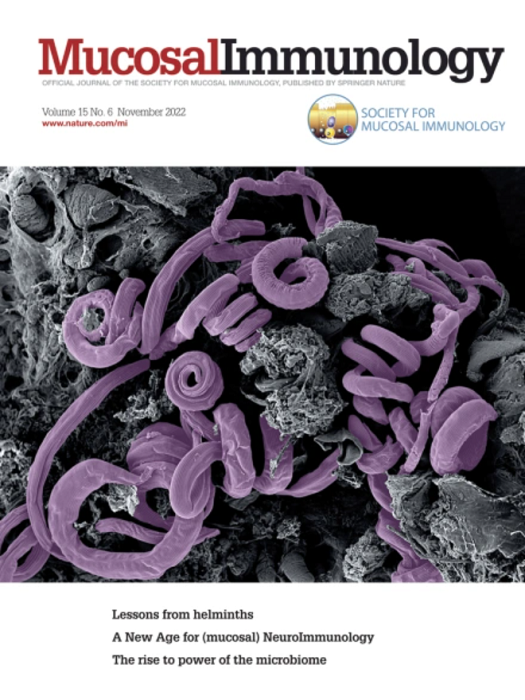Inducible pluripotent stem cells to study human mast cell trajectories
IF 7.9
2区 医学
Q1 IMMUNOLOGY
引用次数: 0
Abstract
Mast cells (MCs) are derived from CD34+ hematopoietic progenitors, consist of different subtypes, and are involved in several inflammatory conditions. However, our understanding of human MC developmental trajectories and subtypes has been limited by a scarcity of suitable cellular model systems. Herein, we developed an in vitro model of human MC differentiation from induced pluripotent stem cells (iPSC) to study human MC differentiation trajectories. Flow cytometry characterization of hemopoietic cells derived from the myeloid cells-forming complex (MCFC) revealed an initial increase in Lin- CD34+ hematopoietic progenitors within Weeks 1–3, followed by an increase in CD34- CD45RA- SSClow and SSChigh hematopoietic cells. The Lin- CD34+ hematopoietic progenitors consisted of SSClow CD45RA- CD123± c-Kit+ FcεRI+ populations that were β7-integrinhigh CD203c+ and β7-integrinhigh CD203c- cells consistent with CMPFcεRI+ cells. Flow cytometry and cytologic analyses of the CD34- Lin- (SSClow) population revealed hypogranular cell populations, predominantly characterized by CD45RA- CD123± c-Kit+ FcεRI- β7-integrinlow and CD45RA- CD123± c-Kit- FcεRI+ β7-integrinMid cells. Analyses of hypergranular SSChigh cells identified Lin- CD34- CD45RA- c-Kit+ FcεRI- and Lin- CD34- CD45RA- c-Kit+ FcεRI+ cells. scRNA-seq analysis of the cells harvested at week 4 of the MCFC culture revealed the presence of monocyte and granulocyte progenitors (n = 547 cells, 26.7 %), Erythrocyte / unknown (n = 85, 4.1 %), neutrophils / myelocytes (n = 211 cells, 10.2 %), mast cell progenitor 1 (n = 599, 29.1 %), mast cell progenitor 2 (n = 152, 7.4 %), committed mast cell precursor (n = 113, 5.5 %), and MCs (n = 353, 17.1 %). In silico analyses of the MC precursor and mature MC populations revealed transcriptionally distinct MC precursor subtype and mature MC states (CMA1+ and CMA1- subtypes). Culturing MC precursor populations in MC maturation media (mast cell media II) led to homogenous mature MC populations as evidenced by high expression of high-affinity IgE receptor, metachromatic granules, presence of MC granule proteins (Tryptase and Chymase) and activation following substance P stimulation and FcεRI crosslinking. This human iPSC-based approach generates MC precursors and phenotypically mature and functional MC populations. This system will be a useful model to generate human MC populations and broaden our understanding of MC biology and transcriptional regulation of MC differentiation trajectories.
研究人类肥大细胞轨迹的可诱导多能干细胞。
肥大细胞(MC)来源于 CD34+ 造血祖细胞,由不同的亚型组成,参与多种炎症的治疗。然而,由于缺乏合适的细胞模型系统,我们对人类 MC 发育轨迹和亚型的了解受到了限制。在此,我们利用诱导多能干细胞(iPSC)建立了人类 MC 分化的体外模型,以研究人类 MC 的分化轨迹。流式细胞术鉴定了来自髓系细胞形成复合体(MCFC)的造血细胞,发现在第1-3周,Lin- CD34+造血祖细胞开始增加,随后CD34- CD45RA- SSCLow和SSChigh造血细胞增加。Lin- CD34+ 造血祖细胞由 SSClow CD45RA- CD123± c-Kit+ FcERI+ 群体组成,该群体为 β7-integrinhigh CD203c+ 和 β7-integrinhigh CD203c- 细胞,与 CMPFceRI+ 细胞一致。对CD34- Lin-(SSClow)群体的流式细胞术和细胞学分析显示了低颗粒细胞群,主要特征是CD45RA- CD123± c-Kit+ FcERI- β7-integrin-low和CD45RA- CD123± c-Kit- FcERI+ β7-integrin-Mid细胞。对超粒 SSChigh 细胞的分析发现了 Lin- CD34- CD45RA- c-Kit+ FceRI- 和 Lin- CD34- CD45RA- c-Kit+ FceRI+ 细胞。对 MCFC 培养第 4 周收获的细胞进行的 scRNA seq 分析显示存在单核细胞和粒细胞祖细胞(n = 547 个细胞,26.7 %)、红细胞/未知细胞(n = 85,4.1 %)、中性粒细胞/骨髓细胞(n = 211,10.2 %)、肥大细胞祖细胞 1(n = 599,29.1 %)、肥大细胞祖细胞 2(n = 152,7.4 %)、肥大细胞前体(n = 113,5.5 %)和肥大细胞(n = 353,17.1 %)。对肥大细胞前体和成熟肥大细胞群进行的硅学分析表明,肥大细胞前体亚型和成熟肥大细胞状态(CMA1+ 和 CMA1-亚型)在转录上截然不同。在 MC 成熟培养基(肥大细胞培养基 II)中培养 MC 前体群体可产生同质的成熟 MC 群体,表现为高亲和力 IgE 受体的高表达、变色颗粒、MC 颗粒蛋白(胰蛋白酶和糜蛋白酶)的存在以及物质 P 刺激和 FceRI 交联后的活化。这种基于人类 iPSC 的方法可产生 MC 前体和表型成熟的功能性 MC 群体。该系统将成为产生人类 MC 群体的有用模型,并拓宽我们对 MC 生物学和 MC 分化轨迹转录调控的理解。
本文章由计算机程序翻译,如有差异,请以英文原文为准。
求助全文
约1分钟内获得全文
求助全文
来源期刊

Mucosal Immunology
医学-免疫学
CiteScore
16.60
自引率
3.80%
发文量
100
审稿时长
12 days
期刊介绍:
Mucosal Immunology, the official publication of the Society of Mucosal Immunology (SMI), serves as a forum for both basic and clinical scientists to discuss immunity and inflammation involving mucosal tissues. It covers gastrointestinal, pulmonary, nasopharyngeal, oral, ocular, and genitourinary immunology through original research articles, scholarly reviews, commentaries, editorials, and letters. The journal gives equal consideration to basic, translational, and clinical studies and also serves as a primary communication channel for the SMI governing board and its members, featuring society news, meeting announcements, policy discussions, and job/training opportunities advertisements.
 求助内容:
求助内容: 应助结果提醒方式:
应助结果提醒方式:


